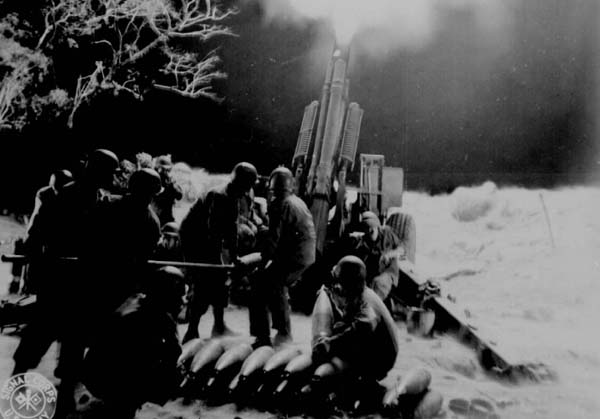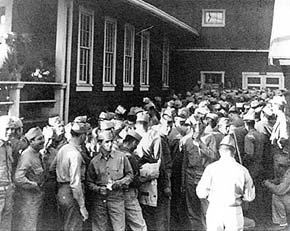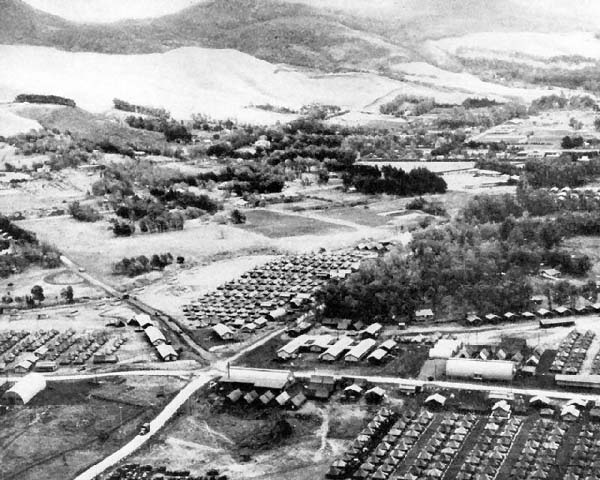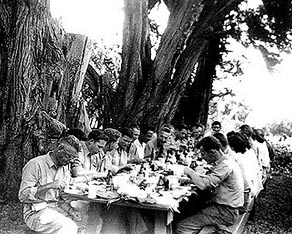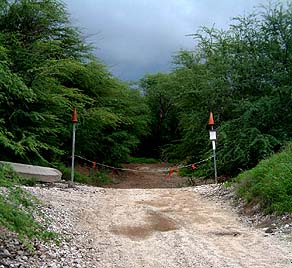 |
 |
 |
|||||
|
|
|||||||
|
|
|||||||
| |
|
|
|
“When the War broke out, we tried to do what we could with our lifestyle,” Papa recounts. “Because Japan bombed Pearl Harbor, all of the beach front areas were all barbered-wire fence. Along the beach, all the way. And so we had our Home Guard. We were caretakers for the shoreline guns. We had big guns there. We took care of that, quite a number of us—maybe one platoon of people. Everyone had one gun to take care of. And we used to do a lot of training, firing and stuff like that, during the War.”
|
||
|
|
||
“During that period of time when the Marines started coming in, it was really busy. You had the whole Division stationed in Waimea. And then Hapuna, Kanoa Beach. You now, we had all those landing craft, all the LST’s, hundreds of them all in the harbor area, coming in and training. Then after training, they loaded up and they were gone. You’d hear they hit in a certain place in the South Pacific after they do that, and get everything in order. “Then they’d return, they’d come back here. Then they’d rest, they’d train and off they’d go again. Finally the last push was Japan. So Kawaihae played a great role in the War. They were training lots over here. Maui did the same thing, Honolulu, all islands, but quite a bit over here. Because the Marines were always up front here.”
|
|
|
"The Nagasawas had a laundry business when the War came," Ku‘ulei explains, "because they took away their boats. The Japanese couldn’t own vessels, so they confiscated their fishing boats and so if they didn’t find something else to do, they were going to perish, because fishing was all they knew. But as the military started coming, they had all the service guys that needed their laundry to be done. "So my Auntie and my Grandma took laundry in. They had like six girls, so they made all the girls wash and press and starch and do all the soldiers’ clothes. I don’t know exactly for how long they had the laundry business, but after the War ended, the laundry business ended, and they moved over to Honolulu, because all the kids had gone to Honolulu."
|
|
|
|
|
“Kawaihae and Waimea took on an additional function during the war," write Chiogioji & Hammatt (1997: 46). "The vast isolated plains of Waimea were an ideal location for a troop training center and in the Spring of 1942 an army recruit camp was built there….At its height, the Waimea camp, consisting of tents and quonset huts set on thousands of acres, housed up to 40,000 men. Troops were shipped in and out through Kawaihae. At the southern end of the bay, in Kawaihae 2nd, amphibious landing exercises were conducted and military emplacements were set up in the area of Pu‘u Kohola heiau.”
|
||
|
|
||
“During the years of the United States’ involvement in World War II (1941-1945), Kawaihae’s role as the shipping outlet for Waimea was intensified. O‘ahu’s burgeoning population of defense workers and military personnel demanded accelerated shipments of cattle from the Parker Ranch through Kawaihae” (ibid.) "When the War started," Lani recalls, "they had barb-wired the whole place, the seashore, because you see the Japanese might invade, come from the ocean, and boy it was a bad. They had barbed wires all over the beach. So then we had to be very careful. But they still brought the cattle down." We will learn about cattle in Kawaihae on the next page. |
|
|
“I believe the military started coming in [to stay] probably in the ‘50s," ‘Ilima notes. "I graduated in 1959 and they were there already, because they were using Pohakuloa as the training site and the only way to get to Pohakuloa would have been through Kawaihae, bringing all their things in through the harbor. “At first, it was the Coast Guard. They would bring their ship, and they would dock. And the Coast Guard would show movies every Saturday night. So everybody would go take their mats, lay it on the wharf and watch movies. That was good. “When they built the big coral flat, they built themselves their own landing, their own wharf, because they would come in with the ship and then just open it up, and the trucks and things would come out. But it used to be that they would land by the old wharf, where Matson is today, and that’s where the Coast Guard would dock too."
|
“The military train up at Pohakuloa, but they also live down at Kawaihae, because they have all of their equipment that they bring in on the LST. So they need to have someone there to watch I guess after their equipment. “There is a military access road that goes up through the mountains, because they don’t use the main highway. So they made their own road to get up to the Saddle Road. Which is good for the people that are using that highway, because if you’re going to up to Honoka‘a or up into Waimea that’s the only road you have, unless you come around and go Kohala way. "That’s the only road, and if you have this heavy equipment using that road, it’s kind of difficult."
|
|
|
|
|
"Now they’re finding a lot of ammo where they practiced," Ku‘ulei points out. "So they’re going around and checking the area. I remember when we were kids, guys would find bombs that didn’t go off, shells that didn’t explode, and so the military would come and detonate everything. Waimea, back there they had a lot of live practice rounds. I guess they didn’t go all the way to Pohakuloa."
|
||
|
|
||
| A prominent feature of village life, both before and after the War, was the cattle drive that came down regularly from Waimea. On the next page, we hear about the role Kawaihae played in the shipping of cattle.
|
||
|
|
||
|
|
|
|
|
|

|
| Kawaihae Home | Map Library | Site Map | Hawaiian Islands Home | Pacific Worlds Home |
|
|
|
|
|
|
|||
| Copyright 2006 Pacific Worlds & Associates • Usage Policy • Webmaster |
|||
